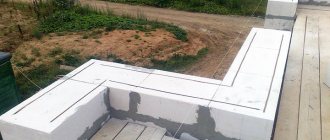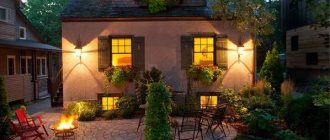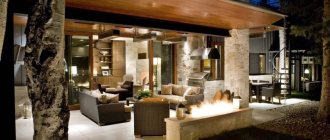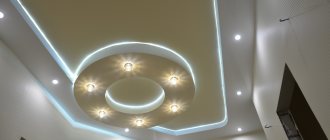Daylight
Natural lighting is taken to be the light emanating from the Sun during the daytime and penetrating into the room. In this case, the methods of entering the premises are as follows:
- through window openings in the side parts of the building (side type);
- through window openings in the upper parts of the building (upper type);
- combination of top and side type (combined type).
With the first and third options, the positive side is that the light spreads evenly in the room, but with the second option, the distribution occurs unevenly.
What is natural light
Natural light is the rays of the sun penetrating into a room. Such flows are comfortable for the eyes and fill the rooms with an atmosphere of comfort.
To “let in” more light into the premises, professionals study the design features of buildings and try to take into account all factors. It is important to know how natural lighting systems are divided. Conventionally, three types can be distinguished:
- Top: Sun rays stream into rooms from openings in the roof. However, this option is only possible for one-story buildings.
- Lateral: flows enter the premises through openings in the walls of the building, that is, through windows. This is the most common way to illuminate rooms.
- Combined: rays fall from both above and from the side. The optimal lighting option, but implemented only in one-story buildings or on the upper floors of multi-story buildings.
The level of natural light can vary significantly even during daylight hours. Ideally, the windows in the room are located on two opposite walls. In this case, there is a chance to catch more sunlight, even if external factors interfere.
Overhead natural lighting of the room
Option for combined natural lighting in the apartment
Lateral natural light through the skylight
Option for side natural lighting through long narrow windows
Important! If there are trees or tall buildings in front of the house, the sun's rays will have difficulty penetrating into the premises. In this case, the problem will have to be solved with the help of artificial lighting.
Artificial lighting
Artificial lighting is considered to be light distributed when there is insufficient illumination or at night in a room. The organization of light is carried out by special devices (incandescent lamps or gas-discharge lamps). Types of artificial lighting: combined and general. Other subtypes: work, emergency (such lighting is divided into safe and evacuation), security and duty. The classification of artificial light with details is given below.
General lighting
Scope of application: for interior spaces. General lighting: uniform or localized. The uniform option leads to effective work on the illuminated area. The localized option installs lighting fixtures near the equipment, making a larger area of the territory suitable for work both during the day and at night.
Points that must be observed when organizing this lighting option:
- if citizens over 40 years of age work in the rooms, then SNiP 05/23/95 obliges them to increase the level of brightness supplied to them;
- When calculating, the degree of reflection from the walls is taken into account.
Zonal and local lighting
Local lighting is used to highlight objects or areas. With this approach, the light source is fixed to a selected area (part of a wall, table, ceiling or other area).
Local lighting is a factor worth considering in interior design. It is important to note that when local lighting is used, the use of the first option is excluded, since when combining options the result will not meet expectations.
Consider the disadvantages of these options. First: it is impossible to change the direction of the main flow of light, increased degree of scattering. Second: illumination of only the selected area, excessively bright light.
When organizing the first or second option, it is worth remembering the following:
- the zonal type provides an extended degree of illumination. It is recommended to use this type in the kitchen, workplace or in a room intended for relaxation from work;
- depending on the specifics of the room, as well as the purpose, it is necessary to determine the lamps that will be used in the room;
- the local type is suitable for a separate area of the workplace, reading room or place with a computer device;
- The local type will be effective if you use directional lighting devices for it.
Decorative lighting
This option is used for private, public or commercial houses. Task: to place accents appropriately, set the mood for the atmosphere, zone the room, making the object attractive in appearance.
Additional types of decorative lighting: static (on-off) or dynamic (wired or wireless control), monochrome or color.
When choosing this option, keep the following in mind:
- since this option is aimed at improving the appearance of the object, there are no specific requirements for brightness or saturation for it, it is recommended to proceed from the specifics of the object in order to achieve favorable parameters for it;
- It is worth distributing light taking into account how it will affect human health. The distribution zones do not need to be made too aggressive in pulsation.
Emergency lighting
This option is used in case of problems with the standard light or other equipment. This type helps to avoid aggravation of the situation (fire, etc.) and facilitates the prompt evacuation of people from a dangerous building. The minimum light with this option is 5% of the normalized values, but not less than 1 lux.
When organizing, it is recommended to consider the following:
- This option is a mandatory measure for industrial premises, for which the lack of light will become critical for normal functioning and will lead to loss of profit, as well as the risk of a fire or other negative phenomenon;
- minimum illumination of not less than 5% and not less than 10 lux for incandescent lamps, 30 lux for fluorescent lamps;
- It is recommended to select diffused type lamps;
- power sources must be independent in nature, since only they will provide emergency operation in a critical situation, and will not be turned off along with other devices if a failure occurs in the building;
- The level of illumination in the rooms must be at least 0.5 lux. This value allows you to install devices at a distance of at least 25 m relative to each other. At the same time, some of the devices are installed at turns, this eliminates the formation of “blind” zones;
- It is recommended to use lamps with diffused light. In addition, it is recommended to place special signs that will direct you to the nearest exit from the premises.
Outdoor and security lighting
The external type is used to illuminate the external perimeter of the territory of an object that needs to be protected. In this case, the same devices are used to perform the task that work in the interior. This allows you to reduce energy consumption.
Security lighting is a complex structure; in its case, the lighting fixtures are arranged so that there are no “blind” areas in the room. It is important to observe this, since the lives and health of people and the safety of property at the enterprise depend on it. When organizing this option, the following must be taken into account:
- the degree of brightness that will need to be provided largely depends on traffic congestion and the number of residents in the city. For example, central highways with traffic of more than 500 cars require lighting of at least 20 lux, local roads with traffic of less than 500 cars on roads - at least 4 lux;
- objects that are heavily located in the shadow should receive at least 0.35 of the total light;
- It is important to consider that when lighting crossings and roads for pedestrians, the time of day also has an impact. In the daytime, the illumination is higher, at night - lower;
- It is best to use diffused type lamps. They provide sufficient brightness and do not hit people’s eyes; this type of light also allows you to increase the distance between devices;
- the duty regime in the premises must function on a permanent basis, since the lives and health of citizens depend on it. It must provide at least 0.5 lux (the exact figure depends on the characteristics of the enterprise where this work is carried out);
- The use of both diffused and directional lamps is allowed. The decision should be determined by the feasibility of application, as well as the solution of the assigned tasks within a particular enterprise, taking into account its characteristics.
Architectural, advertising and display lighting
The task for this type is to create an attractive appearance for the object. Therefore, the requirements are determined according to the specifics of the object to a greater extent, and to a lesser extent - by normative indicators. Among the general requirements, it is worth noting the following:
- This option should not differ much from general city lighting. In the city, the average brightness = 8 cd/m2, for the village - no more than 3 cd/m2;
- if work is carried out on the facade of an object, then the reflection coefficient is also taken into account (determined according to SNiP 23-05-95);
- The distribution of light flux from shop windows should not blind people. The norm for large streets is 300 lux, for small streets - no more than 100 lux. At the same time, if there are light objects on the display case, then the parameter can be reduced by 100 lux, and if there are dark objects, it can be increased by 100 lux.
Types of lighting
Lighting should be chosen not only from the standpoint of originality and attractiveness, but also from the standpoint of its impact on your vision.
The first type of lighting is diffused - it is achieved with soft shadow transitions that are well perceived by the eye and do not create discomfort for it. Typically, such lighting can be achieved using lamps in the form of a sphere or hemisphere with frosted glass. You can also achieve this effect by using halogen lamps on the ceiling. These same halogens will diffuse light well when attached to suspended structures at the ends, especially if their lighting angle can be changed.
Reflected light is no less pleasing to the eye, and is also healthier for it. It is achieved due to the fact that light falls on objects not directly, but by being reflected from walls or other structures. Nowadays, with the help of modern lighting sources, it is not difficult to install such lighting. Many lights have the ability to rotate or change the angle of inclination, which allows you to direct the flow of light onto the wall. There are light sources with a built-in reflector, which greatly simplifies the work. And if your walls feature, say, textile wallpaper or Venetian plaster, you will have the opportunity to better emphasize their attractiveness.
Standard separation
Another division of light source types is made according to the direction of the beam:
- general plan - when the direction is uniform across space;
- directional plan - when the direction is set artificially to illuminate the selected area, the rays are distributed evenly;
- indirect (reflected) plan - when the direction goes to the wall and ceiling, and the uniformity of distribution is obtained due to the reflection that occurs;
- diffuse plan - when the direction passes through a lampshade made of material of a translucent shade;
- mixed plan - when several of the above types are implemented simultaneously.
Established views
When choosing lighting sources, you shouldn’t focus only on chandeliers and sconces - they will certainly provide the required level of illumination, but think about whether it’s time to bring something new to your apartment.
Since Soviet times, the idea has been strengthened in the minds of many of our citizens that lighting is a chandelier under the ceiling and several sconces on the walls. With the help of these simple means, you can certainly set up good lighting. But when the time comes for changes, it’s unlikely that you’ll be able to play with lighting options in the apartment. Abroad, new facets of lighting have long been discovered, and today what can be said about lighting devices is that, in addition to their great variety, they also have mobility.
With the help of modern lighting, you can create a unique composition where diffuse and reflected light, various combinations of color and light can be mixed. It is only important to understand what types of lighting are at our disposal and how to achieve something completely new with their help.
Light in the living room interior
The purpose of the living room is multifaceted; here we gather with the whole family and welcome guests. Therefore, the more different lighting options we think about here, the more convenient it will be. First of all, we install the background main light - this can be one or several chandeliers located in the center or asymmetrically, depending on the area of the room. We hang sconces on the walls.
The living room may have several functional areas - it would be quite appropriate to highlight them with the help of lighting fixtures. You can hang one chandelier over the dining area, the other over the sofa area. Instead of a chandelier, you can use built-in spotlights.
In order to give the living room a “zest”, you can use local or decorative light - illuminate a picture on the wall or put in a prominent place an interesting lamp with high decorative qualities and an unusual shape.
By combining various lighting design options, you can create an atmosphere of coziness and comfort in the living room.
Combined lighting luminaires
The lamps are designed for general and local lighting within functional areas and for orientation in the room (Figure 5).
Figure 5. Combined lighting fixtures
According to the installation method, such lamps can be pendant, with long suspension units, wall, table and floor. Taking into account the variety of functional processes in housing (classes, relaxation, receiving guests, cooking, and so on), combined lighting lamps must be multifunctional with a movable luminous part and provide comfortable conditions in various areas of the apartment. In pendant lamps, this is, first of all, providing the ability to adjust the position of the luminous parts within a wide range in the horizontal and vertical planes, provided that the lamp itself is attached to the electrical outlet in the room located in the middle of the ceiling. In wall, floor and table lamps, this is the presence of telescopic, pantograph or other hinge systems that provide a greater degree of freedom of parts and structures as a whole. It is advisable to use wall or attached lamps as combined lighting fixtures that meet the above requirements, which frees up additional work surface for work. When choosing lamps, it is necessary to take into account in which functional area they will be used, what its dimensions are, as well as the style of the furniture.
Local lighting
Local or local lighting also refers to the main resource for lighting design of a room. Its decorative and functional capabilities allow you to embody many ideas. In rooms where there is no need for a rich, light atmosphere, they easily replace general lighting. Sconces, table lamps or floor lamps illuminate only the main area, and auxiliary lighting completes the light picture.
Local lighting creates an intimate, calm atmosphere, conducive to relaxation and rest, so it should be present in all rooms where a person spends a lot of time. When choosing local lighting, you should pay attention to devices with movable arms, rotation and brightness controls. All this will allow you to adjust the level of light that will allow you to feel comfortable, as well as change the light pattern from time to time.
Features and functions of LED backlight
LED elements used for illumination differ better from analogues in the following number of parameters:
- Economical.
- Durability.
- Compactness.
- Strength.
- Heat dissipation.
- Brightness and the ability to adjust it.
- Combination with interior items.
- Wide range of colors.
Due to these features, ice lighting is everywhere replacing both traditionally used incandescent light bulbs and their energy-saving analogues. Many manufacturers today produce lamps designed for the installation of LED elements or in a universal housing with the possibility of installing them along with other light sources.
Ice lighting is characterized by wide functionality:
- As an element of additional lighting of rooms and their elements at night - corridors, steps, hallways.
- Contour-light zoning of various objects.
- Increasing visual volume by highlighting mirrors, niches, and cornices.
- Decoration of various items and accessories.
- Decoration.
Note! Due to their high resistance to external factors, energy efficiency and versatility, diode lamps can be used in any area of lighting - auto, motorcycle, bicycle equipment, furniture structures, water tanks, showers, baths, plumbing fixtures and many other objects and items. At the same time, making it with your own hands does not require special knowledge and experience.
Work lighting
Such lighting is used to illuminate a small space where you need to focus on details and concentrate your attention - sewing, drawing, working on a computer, etc. If the light is insufficient or, conversely, excessive, it will create a lot of inconvenience during the work process. This problem can be avoided with a well-thought-out combination of several independent lamps with varying degrees of brightness. In addition to working light, this room should also have a main light - the contrast between the darkness around and the intense illumination of the workplace tires the eyes and reduces productivity.
The optimal combination is the main light plus a flexible table lamp. The thinner and more painstaking the work, the stronger the source of working light should be. Please note that incandescent lamps are not suitable for all types of work - they leave glare and heat the surface. It is better to give preference to halogen lamps - they are more durable and have characteristics similar to natural light.
Accent lighting
Accent lighting is used to highlight individual interior elements. It combines aesthetic and functional properties - the illuminated object becomes easy to use and pleasant to see. The most effective lighting is with a general dim light background.
This type of lighting is very popular among designers, who can use it to create elegant artistic solutions. Most often, decorative elements, glass shelves and racks, and paintings are illuminated.
Illuminated niches turn into fabulous miniature castles. Lighting is an excellent way to transform ordinary things into unusual and festive ones. Accent lighting makes furnishings such as kitchen drawers and cabinets feel warmer and more familiar.
For lighting, LED lamps are usually used, which operate at constant current, do not heat surfaces above 40 degrees and ensure fire safety. Due to their moisture resistance, they are often used in bathroom or kitchen decoration. LEDs go well with plastic elements. They do not cause aging and the formation of yellowness, which is caused by ultraviolet radiation.











